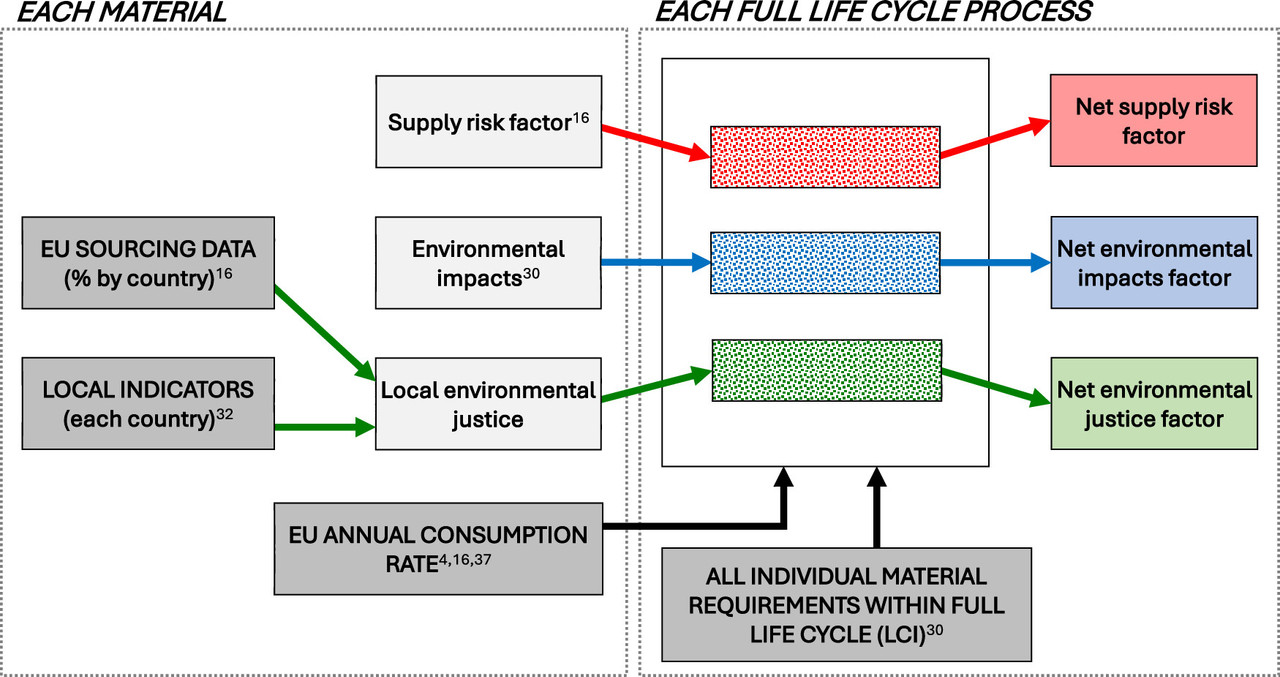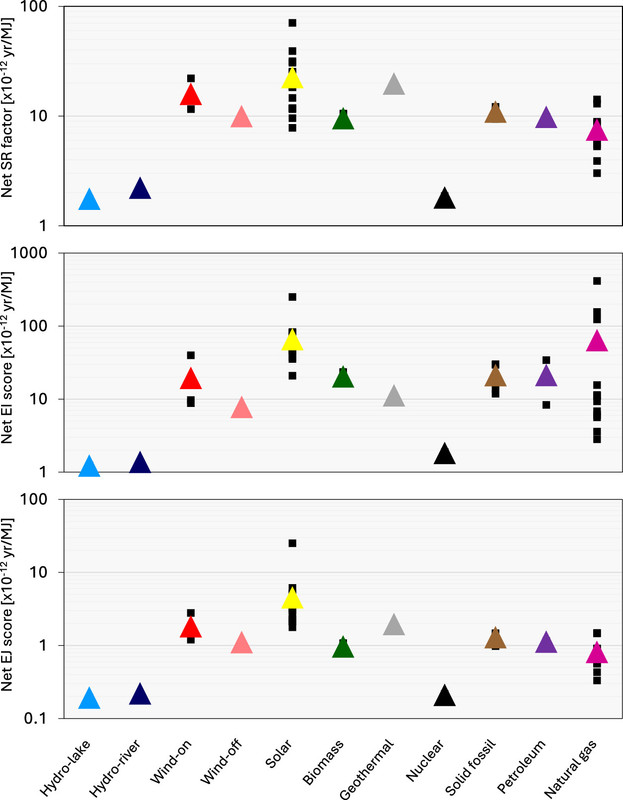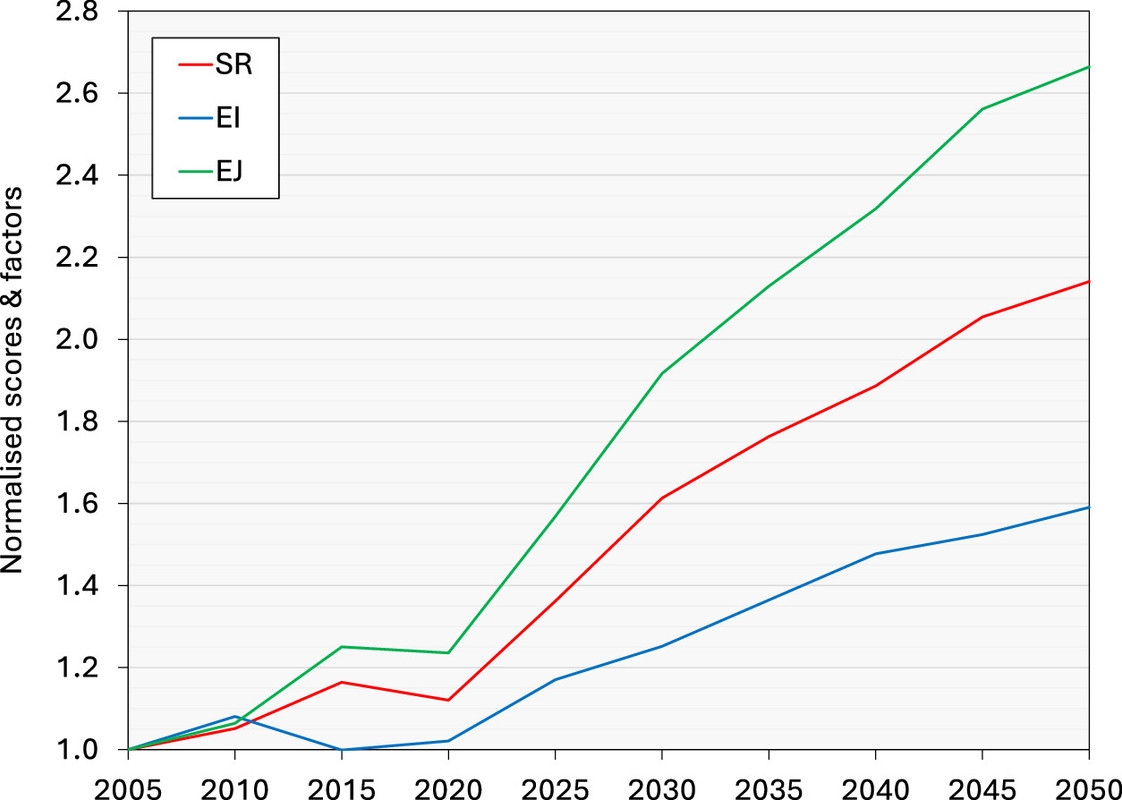Environment & Energy
Related: About this forumWeighting Critical Materials, Environmental Impact, and Environmental Justice in Energy and Tech.
Last edited Mon Jan 2, 2023, 10:58 AM - Edit history (1)
The paper I'm about to discuss has a title that is a little narrower than what the text covers: New Techniques for Assessing Critical Raw Material Aspects in Energy and Other Technologies Nick Martin, Cristina Madrid-López, Gara Villalba-Méndez, and Laura Talens-Peiró Environmental Science & Technology 2022 56 (23), 17236-17245.
Besides intrinsic material considerations, something that often catches my attention, it considers environmental impact, in a broad sense, a widely employed metric albeit with variable weightings depending on the analytical focus, often but not always limited to climate change, but also another emerging category, one I think should be discussed, environmental justice.
Of course, these three metrics are interrelated. I often discuss the issue of cobalt slaves in the DRC in connection with the "batteries will save us" rhetoric that is supposed to make us all believe that someday solar and wind energy will be meaningful and clean despite their existing, rather deadly as it works out, unreliability and the trivial amounts of energy they produce after soaking up and continuing to soak up multiple trillion dollars sums of money. Cobalt slavery is obviously - or should be obviously - an environmental justice issue. Other mining of course, also involves justice issues.
The cited paper purports to integrate these metrics, and I found it to be worthwhile reading. It focuses, by the way, on the EU, the part of the world most affected by the German decision to send Putin lots of money for gas, oil and coal so they could be "green" and he could fund a war in Ukraine.
The EU is "supply risk" hell right now.
Some excerpts:
However, the concept of sustainability in energy systems is evolving beyond the mere reduction of GHG emissions. Among other things, the ongoing sourcing of the raw materials and components required to implement new infrastructure continues to gain policy focus (4?8) and mainstream media attention, (9?13) and several potential “roadblocks” have been identified. The range of issues triggered by the COVID-19 pandemic and war in Ukraine has further highlighted the vulnerability of infrastructure development to supply chain disruptions. (14,15)
A number of specific concerns have been raised in this regard, mostly surrounding the available stocks of necessary materials, (16?18) geopolitical and governance issues associated with supplying countries, (19?21) and the issues of social justice and localized environmental damages that surround the increased demand for materials. (22?24) All three aspects are likely to play a role in determining the speed and direction of the energy transition going forward. The European Commission (EC) has begun to quantify supply risk for specific materials (16) and now includes geographical concentration and governance, import reliance, and responsible sourcing aspects as part of its triennial “Raw Materials Scoreboard” assessments. (25) A handful of additional studies have also attempted to measure other aspects of material sourcing, particularly in relation to justice and conflict issues. (26?28) However, these assessments generally only apply to individual materials. As such, despite a relative paucity of suitable data, a clear need for the quantification of raw material-related constraints relating to individual technologies and processes is arising, particularly for those attempting to optimize systemwide transition pathways and minimize the exposure of these pathways to risk.
To bridge this gap, we present here a series of methods─developed for assessing energy system characteristics as part of the SENTINEL project (29)─that use raw material inventory information from life cycle assessment (LCA) databases alongside other data sources to generate three unique indicators specifically related to the supply of raw materials. First, the risk of interruption to raw material supply channels is quantified by incorporating supply risk data published by the EC. (16) Two further indicators attempt to quantify the possibility of localized issues occurring during the extraction and processing of raw materials: the potential to exacerbate local environmental conditions is estimated using ecosystem and human health data relating to individual materials from the Ecoinvent LCA database, (30,31) while the potential to reproduce local environmental justice issues is quantified using data relating to sourcing countries within the Worldwide Governance Indicators (WGI) data set. (32,33) Collectively, we believe these three indicators represent the majority of key issues in relation to raw material supply at present...
I have a slight disagreement with the text: I don't believe policy makers are doing shit to address climate change, although, albeit it quietly, the Biden administration is beginning to appreciate and support nuclear energy. They haven't "agreed" to anything realistic to address climate change.
There's some commentary on methods for determining the materials of interest:
...The methods use 55 of the raw materials identified as being most important to the EU in accordance with the latest list of so-called critical raw materials (CRMs) published by the EC. The most recent investigation, from 2020, (16) considers a group of 80 materials as potential CRM candidates, of which 44 were deemed critical using a standardized methodology (35) based on economic importance and supply risk factors. The list includes the five platinum group metals, 10 heavy rare earth, and five light rare earth elements; holmium, thulium, lutetium, and ytterbium are grouped as a single heavy rare earth entry...
They seem to include all of the lanthanides, There are actually 14 lanthanides, but often an element that is not technically a lanthanide (lacking 4f electrons) but behaves like them and is always found in their ores, yttrium, is included as a "lanthanide."
I'd guess among the "platinum group" osmium didn't make the cut; Europe has an intrinsic, if minor, source of three of these elements, rhodium, ruthenium and palladium in used nuclear fuel, but in Western Europe, if not Eastern Europe, they're afraid of nuclear energy; they'd rather kill people by using other energy sources.
Anyway, to continue...
Supply risk:
Here, a composite SR indicator for a particular process is created by summing all SR factor values in proportion to the amount of the corresponding material required (mass) to produce one unit of the final “product” defined by the LCI. Initial attempts at deriving the indicator considered only these two inputs. However, it was soon discovered that using “raw” values of material requirement placed a large bias on materials used in larger amounts; this tended to vastly overshadow the significance of scarce materials used in much smaller amounts. For example, although both are considered to be CRMs, the required and available masses of materials such as silicon or titanium can be up to 5 orders of magnitude higher than those of rare earth materials. To overcome this bias, EU annual consumption levels (4,16,37) were used as a “scaling” measure to represent the relative magnitudes of the requirements for different materials in the EU...
Local Environmental Impacts:
...The ecosystem quality indicator aggregates values for terrestrial acidification, terrestrial ecotoxicity, freshwater ecotoxicity, marine ecotoxicity, freshwater eutrophication, agricultural land occupation, urban land occupation, natural land transformation, and climate change (on ecosystems). Analysis of the data suggests that this indicator is overwhelmingly influenced by some combination of marine ecotoxicity, natural land transformation, and climate change values for all materials examined. Meanwhile, the human health indicator aggregates values for human toxicity, photochemical oxidant formation, particulate matter formation, ionizing radiation, ozone depletion, and climate change (on human health). In this case, the indicator is overwhelmingly influenced by human toxicity values for all materials. A simple average of the net ecosystem quality and human health indicators was used as the final environmental impact (EI) value for each material. Although it is acknowledged that these impacts could occur anywhere along the supply chain of these raw materials, it is assumed here that a significant amount is directly related to the extraction and processing operations that occur near or close to their source locations...
And now the third, and somewhat more difficult to quantify issue, but one that's very real for, say, cobalt slaves, environmental justice:
The authors rely on something called the "World Governance Index" and other metrics to come up with their weighting.
This index apparently evaluates the following parameters according to the text:
It doesn't seem to mention slavery, but OK...
Three graphics from the paper give an overview of the method, the results, and the prediction of impacts in the future normalized to the already dire and unsustainable state of affairs in 2005.
The graphic for the methods:

The caption:
The graphic for the results:

The soothsaying graphic:

The authors say this about their findings:
I have no idea what the authors mean by "lake hydro" as opposed to "river hydro" so don't ask me.
In the discussion, the authors say this about sources:
Meanwhile, China is a known producer of 39 of these 44 materials and is responsible for over 80% of current global supplies of 16 such materials, including gallium, germanium, and all light and heavy rare earth metals, all of which are important in the manufacture of wind turbines and solar PV panels...
Some brief de rigueur mention of recycling follows, but then some acknowledgement of something called "reality" as in the reality of recycling from diffuse sources:
I note that recycling, which involves overcoming the entropy of mixing as well as transport costs of collection, requires energy.
I credit the authors for being pretty frank about the internationally applauded cult of so called "renewable energy."
...but they still, despite this somewhat realistic caveat, still call this stuff "renewable." It is an unavoidable locution, I guess, not even remotely reality based, but common nonetheless...
And of course, despite the results they call a "clear pattern" where nuclear is concerned, they do need to include the usual vague ("there has to be something wrong with it - it's in our religion" ) "controversies" but nonetheless face what their data says:
I do think they are underestimating the supply risk associated with hydropower, since 2022 clearly demonstrated at all the world's major rivers are at risk, and I would add that biomass requires both moderate temperatures and, ultimately rain.
Of course the "controversies" about nuclear energy do have environmental impact. I have convinced myself that the coal, gas and oil burned to power computers for people to carry on endlessly and mindlessly about the big boogeyman at Fukushima have produced enough air pollution to kill far more people than radiation releases there ever did or ever will.
I wish you the happiest of New Years.
2naSalit
(86,650 posts)Thanks for posting!
Happy New Year! ![]()